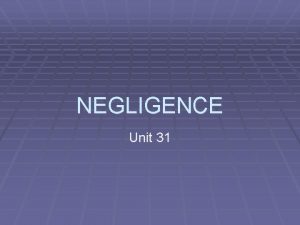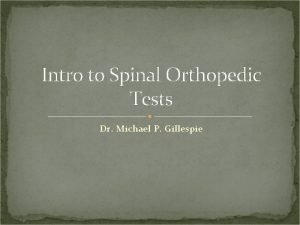Duty of Care Duty of Care Donoghue v






- Slides: 6

Duty of Care

Duty of Care – Donoghue v Stevenson • Mrs D and her friend went to a café. Mrs D’s friend purchased ice cream and ginger beer (contained in an opaque bottle – could not see the contents). Mrs D drank some of the ginger beer then poured the remainder into her glass and the decomposed remains of a snail came out of the bottle. This appalled Mrs D and she became ill as a result of the sight and the ginger beer she had already drunk • Mrs D had no direct claim against manufacturers or shopkeeper based on contract as she did not buy the ginger beer. Mrs D’s friend could claim against the café in contract but had not suffered any loss apart from buying defective goods – could get her money back but nothing for Mrs D’s illness. • Mrs D claimed damages against the manufacturer, S. Her claim was for the resulting shock and stomach upset • Case led to the neighbour principle – “persons who are so closely and directly affected by my act that I ought reasonably to have them in contemplation as being so affected when I am directing my mind to the acts or omissions which are called into question • Neighbour principle is based on “love thy neighbour” from the Bible • Principle makes it clear that there can be liability without a contract which led to law developing the rules of negligence

Duty of Care – Caparo v Dickman – three-part test • Neighbour principle from Donoghue v Stevenson soon became seen as too simplistic – too easy to impose a duty of care on people • Caparo v Dickman – 3 part test to see if a duty of care exists – all 3 elements must be demonstrated: 1. It was reasonably foreseeable that a person in C’s position would be injured 2. There was sufficient proximity between the parties 3. It is fair, just and reasonable to impose liability on D

1. Foreseeability • Objective test – would a reasonable person in D’s position have foreseen that someone in C’s position might be injured? • E. g. in D v S – failing to stop a snail getting into a bottle will affect the person drinking the contents – reasonable person in D’s position (soft -drink manufacturer) would foresee that C (a consumer) would be injured • Kent v Griffiths – ambulance service owed a duty of care to a member of the public on whose behalf a 999 call had been made – it was reasonably foreseeable that a person in C’s position would be further injured if the ambulance failed to arrive or took too long to arrive

2. Proximity • Closeness • Proximity can be by space, time or relationship • Bourhill v Young – C getting off a tram when she heard a motorcycle go past and almost immediately heard a collision. C did not see the accident and was a safe distance away from it. Decided to go and see what had happened and saw the dead motorcyclist and the aftermath. Suffered shock from what she had seen and claimed the shock caused her to miscarry her baby. Held that D did not owe her a duty of care as she had not seen the accident and was in a safe place but chose to see the aftermath voluntarily – no proximity • Mc. Gloughlin v O’Brien – Mrs M told of a serious accident involving her husband children. She was nowhere near the accident but told of it a short time afterwards. She rushed to the hospital and discovered that one of her children had died, the other was seriously ill and her husband was very distressed and in great pain. She suffered shock. Held that the person who caused the accident owed her a duty of care even though there was no proximity of time and space as there was proximity of relationship

3. Fair, Just and Reasonable • Whether it is fair, just and reasonable to impose a duty of care • Matter of public policy: • Courts are concerned about not opening the “floodgates of litigation” – encouraging a huge number of claims • What is best for society as a whole – Ds in the public sector are more likely to have claims against them fail as it is not fair, just and reasonable to impose liability on them – e. g. police need to be able to act without undue worry about negligence claims against them • Hills v Chief Constable of West Yorkshire – no duty of care on the police to the mother of the Yorkshire Ripper’s last victim. Police had already interviewed and released YR before he killed again, but court held there was no duty of care to future victims – this was a policy consideration to allow the police to work as efficiently as possible • MPC v Reeves – police took a man into custody who was a prisoner known to be at risk of committing suicide. Hanged himself while in his cell – held that the police owed him a duty of care











